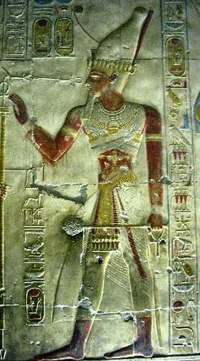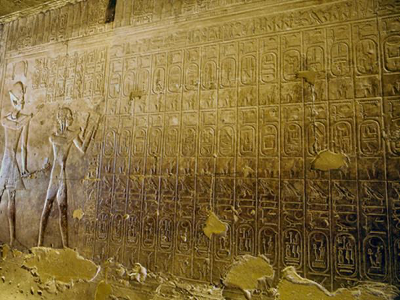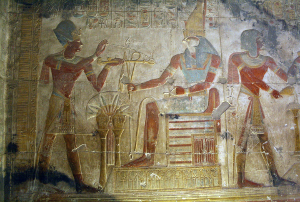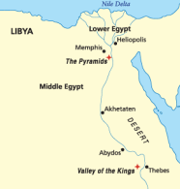Abydos: Royal Burial Center of Ancient Egypt
The name was Abdju in the language of Ancient Egypt. Abydos comes from a Greek association with the city of the same name in that civilization. Many of the oldest tombs are in a place named Umm el Ga'ab. Tombs found include the kings of the first two dynasties, including Narmer, believed to the first king to unite Lower Egypt and Upper Egypt. Some excavations have turned up references to King Scorpion, one of Ancient Egypt's earliest (perhaps mythical) figures. Many later kings dictated their burials at Abydos as well. 
One of the well-known pharaoh-built constructions was the Temple of Seti I, built about 1300 B.C. The namesake pharaoh and his Ramses II ordered built the L-shaped limestone and sandstone temple, which was dedicated to several gods, among them Amen-Ra, Horus, Isis, Osiris, Ra-Horakthy, and Ptah. Unifying the several sanctuaries within the temple area are two Hypostyle halls, one supported by 24 columns containing artwork showing episodes from the life of Ramses II and the other sporting 36 columns showing scenes from other aspects of Egyptian life. Attached to this temple is another one, known as the Osireion, which has an underground entry to the main chamber and was thought to be used in some way for the worship of Osiris. 
Perhaps most intriguing to historians has been the temples King List, also called Abydos Table. On the list are the names of 76 kings, from the earliest days. The list is in the form of three rows, each of which has 38 cartouches. Two of the rows contain the names of 38 kings; the other row contains nothing but Seti's name, over and over again. The King List is also notable for two names that are missing: The chronology skips over both Akhenaten and Hatshepsut because Seti I, in particular, but others as well considered those two monarchs illegitimate. Ramses II had built his own temple, which is now called the Portal Temple because one of its main remaining features is a giant archway. Among the scenes reliefs shown on the walls of this temple was the famous Battle of Kadesh. 
An even larger temple, the Great Osiris Temple, once stood at Abydos. Its mud brick construction didn't lend kindly to the years going by, and most of this temple now lies in ruins. Items found within the ruins date to the First Dynasty. The Festival of Osiris, one of Egypt's most sacred ceremonial events, began in this temple. One of the most recent discoveries is a temple ordered built by the pharaoh Thutmose III, who was so successful in battle that he was known as "the Napoleon of Egypt." Other famous kings buried at Abydos include Ahmose I, who rallied Thebes and all of Upper Egypt to effect the overthrow of the Hyksos. This pharaoh began construction of a pyramid that was not completed. Once nearly 200 feet tall, it now stands as a 32-foot-tall ruin. A nearby pyramid temple illustrates Ahmose's ouster of the Hyksos. Also found buried at Abydos were a number of wooden boats, possibly to help the ancient kings make the journey into the afterlife. The Ancient Egyptians buried their rulers and other leaders elsewhere, of course, most notably at Saqqara, at Giza, and in the Valley of the Kings. |
|
Social Studies for Kids
copyright 2002–2025
David White



 Abydos, about 300 miles south of what is now Cairo in Upper Egypt on the western side of the Nile, was the burial place of the leaders of Egypt from earliest times. Stretching over five square miles, it was the center of the cult of Osiris, god of the dead, and the home to many temples built by pharaohs.
Abydos, about 300 miles south of what is now Cairo in Upper Egypt on the western side of the Nile, was the burial place of the leaders of Egypt from earliest times. Stretching over five square miles, it was the center of the cult of Osiris, god of the dead, and the home to many temples built by pharaohs.
